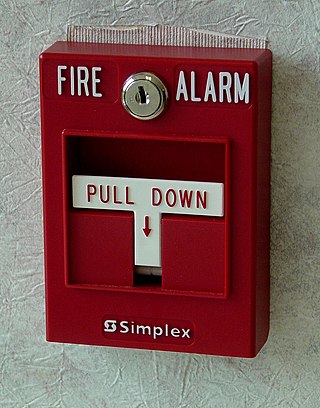
An alarm device is a mechanism that gives an audible, visual, combination, or other kind of alarm signal to alert someone to a problem or condition that requires urgent attention.

The UL enterprise is a global private safety company headquartered in Northbrook, Illinois, composed of three organizations, UL Research Institutes, UL Standards & Engagement and UL Solutions.

A smoke detector is a device that senses smoke, typically as an indicator of fire. Smoke detectors/Alarms are usually housed in plastic enclosures, typically shaped like a disk about 125 millimetres (5 in) in diameter and 25 millimetres (1 in) thick, but shape and size vary. Smoke can be detected either optically (photoelectric) or by physical process (ionization). Detectors may use one or both sensing methods. Sensitive alarms can be used to detect and deter smoking in banned areas. Smoke detectors in large commercial and industrial buildings are usually connected to a central fire alarm system.

A fire alarm notification appliance is an active fire protection component of a fire alarm system. A notification appliance may use audible, visible, or other stimuli to alert the occupants of a fire or other emergency condition requiring action. Audible appliances have been in use longer than any other method of notification. Initially, all appliances were either electromechanical horns or electric bells, which would later be replaced by electronic sounders. Most of today's appliances produce sound levels between 70 and 100 decibels at 3 ft.
A buzzer or beeper is an audio signaling device, which may be mechanical, electromechanical, or piezoelectric. Typical uses of buzzers and beepers include alarm devices, timers, train and confirmation of user input such as a mouse click or keystroke.

In railway signalling, an interlocking is an arrangement of signal apparatus that prevents conflicting movements through an arrangement of tracks such as junctions or crossings. In North America, a set of signalling appliances and tracks interlocked together are sometimes collectively referred to as an interlocking plant or just as an interlocking. An interlocking system is designed so that it is impossible to display a signal to proceed unless the route to be used is proven safe.

A security alarm is a system designed to detect intrusions, such as unauthorized entry, into a building or other areas, such as a home or school. Security alarms protect against burglary (theft) or property damage, as well as against intruders. Examples include personal systems, neighborhood security alerts, car alarms, and prison alarms.

A fire alarm control panel (FACP), fire alarm control unit (FACU), fire indicator panel (FIP), or simply fire alarm panel is the controlling component of a fire alarm system. The panel receives information from devices designed to detect and report fires, monitors their operational integrity, and provides for automatic control of equipment, and transmission of information necessary to prepare the facility for fire based on a predetermined sequence. The panel may also supply electrical energy to operate any associated initiating device, notification appliance, control, transmitter, or relay. There are four basic types of panels: coded panels, conventional panels, addressable panels, and multiplex systems.
This is a glossary of firefighting equipment.
SimplexGrinnell, a subsidiary of Johnson Controls, is an American company specializing in active fire protection systems, communication systems and testing, inspection and maintenance services. The company headquarters is in Boca Raton, Florida; corporate sales and marketing offices are in Westminster, Massachusetts, and the company has about 160 district offices throughout North America. It is currently the largest fire protection company in the world.

Manual fire alarm activation is the process of triggering a fire alarm through a call point, pull station, or other device. This usually causes the alarm to sound the evacuation signal for the relevant building or zone. Manual fire alarm activation requires human intervention, as distinct from automatic fire alarm activation such as that provided through the use of heat detectors and smoke detectors. It is, however, possible for call points/pull stations to be used in conjunction with automatic detection as part of the overall fire detection and alarm system. Systems in completed buildings tend to be wired in and include a control panel. Wireless activators are common during construction.

A fire alarm system is a building system designed to detect, alert occupants, and alert emergency forces of the presence of fire, smoke, carbon monoxide, or other fire-related emergencies. Fire alarm systems are required in most commercial buildings. They may include smoke detectors, heat detectors, and manual fire alarm activation devices. All components of a fire alarm system are connected to a fire alarm control panel. Fire alarm control panels are usually found in an electrical or panel room. Fire alarm systems generally use visual and audio signalization to warn the occupants of the building. Some fire alarm systems may also disable elevators, which are unsafe to use during a fire under most circumstances.

Wheelock is a fire alarm and general signaling products manufacturer owned by Eaton Corporation.
An annunciator panel, also known in some aircraft as the Centralized Warning Panel (CWP) or Caution Advisory Panel (CAP), is a group of lights used as a central indicator of status of equipment or systems in an aircraft, industrial process, building or other installation. Usually, the annunciator panel includes a main warning lamp or audible signal to draw the attention of operating personnel to the annunciator panel for abnormal events or condition.

The firm S. H. Couch, often known as simply Couch, was a Quincy, Massachusetts, manufacturing company founded circa 1901 in Boston after the dissolution of Whitman & Couch, a partnership, and a second entity known as Couch & Seeley. S. H. Couch launched during and participated in the turn of the century Independent Telephone Movement which ensued after the expiration of the foundational Bell telephone patents in 1894. The company specialized in electrical devices including telephones, intercoms, and fire alarm systems. S. H. Couch had offices in Boston and in Chicago by 1907.
PLCBUS or PLC-BUS is a proprietary power-line communication protocol for communication between electronic devices used for home automation. It primarily uses power line wiring for signaling and control.

Honeywell Gent, formerly Gents' of Leicester, is a British manufacturer of life safety equipment based in Leicester, England. Established by John Thomas Gent, the company is thought to have started in 1872 however it could have been trading as early as the 1860s. The company had a workforce of several hundred at its height.
Autocall is a company that specializes in fire protection and customized communications equipment. The original company was founded in 1908 and was based in Shelby, Ohio. The Autocall brand became defunct in 2001 after it was incorporated into the SimplexGrinnell merger by Tyco International. On September 6, 2016, Johnson Controls and Tyco completed a merger, and Johnson Controls relaunched the Autocall brand in late 2017.
An emergency communication system (ECS) is any system that is organized for the primary purpose of supporting one-way and two-way communication of emergency information between both individuals and groups of individuals. These systems are commonly designed to convey information over multiple types of devices, from signal lights to text messaging to live, streaming video, forming a unified communication system intended to optimize communications during emergencies. Contrary to emergency notification systems, which generally deliver emergency information in one direction, emergency communication systems are typically capable of both initiating and receiving information between multiple parties. These systems are often made up of both input devices, sensors, and output/communication devices. Therefore, the origination of information can occur from a variety of sources and locations, from which the system will disseminate that information to one or more target audiences.

System Sensor is an American manufacturer of fire protection equipment. Headquartered in St. Charles, Illinois, System Sensor is a subsidiary of Honeywell International. System Sensor develops and distributes fire alarm devices such as notification appliances, fire detectors, manual initiating devices, CO detectors, and more fire protection devices for multiple markets across the globe, and for other Honeywell companies.













